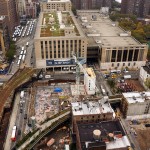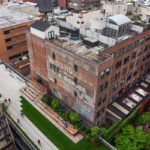An ongoing series of LivinTheHighLine features that unpacks the history — human, industrial, architectural — of a single building near the High Line, using aerial, archival, and contemporary photography. Click here for the “What’s That Building?” feature that covers a great many buildings, both new and old, along the High Line Corridor.
 The Whitney Museum of American Art: Gansevoort Street. The new home of one of the city’s most important and beloved museums, “This building talks to the city,” as its architect Renzo Piano explained during the opening ceremony. “I’m pretty sure that beauty will save the world,” he also said, and when you spend time in this extraordinary building you may be inclined to agree. This article pulls back the layers of history in the landscape as a way of introducing the reader to Piano’s building.
The Whitney Museum of American Art: Gansevoort Street. The new home of one of the city’s most important and beloved museums, “This building talks to the city,” as its architect Renzo Piano explained during the opening ceremony. “I’m pretty sure that beauty will save the world,” he also said, and when you spend time in this extraordinary building you may be inclined to agree. This article pulls back the layers of history in the landscape as a way of introducing the reader to Piano’s building. The Morgan General Mail Facility: Tenth Avenue between 28th – 30th Streets. Spanning three centuries, from the 1860s to the 21st century, this massive complex and the land it sits on offer up many threads in the history and culture of New York City. When it was railroad station Abraham Lincoln passed through it twice — on his way to Washington as President and in his funeral train four years later. It has one of the first and largest green roofs in the world, and remains one of the busiest facilities in the United States Postal Service.
The Morgan General Mail Facility: Tenth Avenue between 28th – 30th Streets. Spanning three centuries, from the 1860s to the 21st century, this massive complex and the land it sits on offer up many threads in the history and culture of New York City. When it was railroad station Abraham Lincoln passed through it twice — on his way to Washington as President and in his funeral train four years later. It has one of the first and largest green roofs in the world, and remains one of the busiest facilities in the United States Postal Service. Global Warehouse to “World School”: Tenth Avenue between 25th – 26th Streets. This article looks at the history of the R.C. Williams Company — one of America’s first truly global companies — which built this Cass Gilbert-designed warehouse along the High Line and became its first client in August 1933. Today it’s home to the Avenues School, which welcomed its first students in 2013.
Global Warehouse to “World School”: Tenth Avenue between 25th – 26th Streets. This article looks at the history of the R.C. Williams Company — one of America’s first truly global companies — which built this Cass Gilbert-designed warehouse along the High Line and became its first client in August 1933. Today it’s home to the Avenues School, which welcomed its first students in 2013. The Spears Building: 22nd Street between Tenth & Eleventh Avenues. This building has a long history, beginning in the 1880s when it was cigarette packing factory. In the High Line era it was warehouse for Spear & Co., a large furniture maker, and today it’s a condominium. The “seating steps” of the High Line’s lawn abut the east-facing side of the building, and its most distinctive graffiti, by the famous tagger REVS COST, was happily saved from the NYC graffiti police.
The Spears Building: 22nd Street between Tenth & Eleventh Avenues. This building has a long history, beginning in the 1880s when it was cigarette packing factory. In the High Line era it was warehouse for Spear & Co., a large furniture maker, and today it’s a condominium. The “seating steps” of the High Line’s lawn abut the east-facing side of the building, and its most distinctive graffiti, by the famous tagger REVS COST, was happily saved from the NYC graffiti police. The Westyard Distribution Center: Known today as Manhattan West, this massive building is officially located at 450 W. 33rd, but extends between 31st-33rd Streets and takes up the full superblock between 9th and 10th Avenues. Once a famous example of Brutalism in architecture (until it was brutally re-fenestrated), this oddly shaped, massive structure has a longstanding connection to three different railroads in New York City. This article presents a 360-degree tour.
The Westyard Distribution Center: Known today as Manhattan West, this massive building is officially located at 450 W. 33rd, but extends between 31st-33rd Streets and takes up the full superblock between 9th and 10th Avenues. Once a famous example of Brutalism in architecture (until it was brutally re-fenestrated), this oddly shaped, massive structure has a longstanding connection to three different railroads in New York City. This article presents a 360-degree tour.

